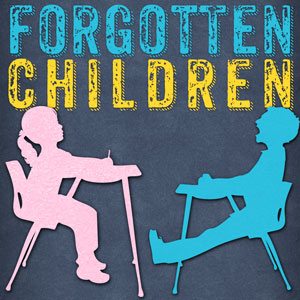Forgotten Children
When it comes to mental disorders, 10% of our children are falling through the cracks.
There are roughly 315 million people in the US with 1/4th of the population under the age of 18 (About 78 million children). 1/5th of those have a mental disorder (about 15 million) and 1/2 of children with mental disorders will never receive help (about 7.5 million) – that’s 10% of children and 2.5% of the population.
Childhood mental disorders can include:
Major Depressive Disorder
Dysthymia
Bipolar Disorder
Attention Deficit Hyperactivity Disorder (ADHD)
Oppositional Defiant Disorder (ODD)
Generalized Anxiety Disorder
Separation Anxiety Disorder
Posttraumatic Stress Disorder (PTSD)
Obsessive-Compulsive Disorder (OCD)
Social Phobia
Specific Phobia
These disorders in children can lead in adulthood to:
Substance use, abuse, or dependence
Sexual risk-taking behavior
Criminal behavior
Poor coping and social skills
Suicide
Percent of children ages 3-17 who currently have a mental disorder:
AD/HD
6.8% 4,188,000
Behavioral or conduct problems
3.5% 2,156,000
Anxiety
3.0% 1,848,000
Depression
2.1% 1,293,000
Autism spectrum disorders
1.1% 678,000
Tourette syndrome
0.2% 99,000
Illicit drug use disorder
4.7% 1,155,000
Alcohol use disorder
4.2% 1,028,000
Cigarette dependence
2.8% 691,000
An estimated 40% of children with mental disorders have more than one.
Mental disorders are among the most costly conditions to treat in children. The cost of mental disorders among persons under aged 24 in the U.S. is $247 billion. (including health care, use of services such as special education and juvenile justice, and decreased productivity)
ADHD
4-6%: percentage of the U.S. population with ADHD.
2-5% adults
3-7% children estimated to have ADHD / 8-10% for school aged children
There is a 25-35% chance of having ADHD if a family member has it, compared to 4-6% without a family history.
Overlooked Adults
• 1/2 – 2/3 of children with ADHD continue to have symptoms into adulthood.
• 50% of the doctors said they do not feel confident in diagnosing ADHD in adults, here’s why…
• Adults consider their problems to be the result of character flaws.
• Patients who live with AD/HD or ODD tend to assume that it is normal.
• Many people presume that ADHD is a male disorder in childhood.
• Everyone exhibits some of these symptoms some of the time.
Overlooked Girls
• Boys are 3x more likely to be diagnosed than girls.
• Men are 2x more likely to be diagnosed than women.
• Females are more likely to go undiagnosed because…
• ADD is still presumed to be a male disorder
• Girls are more likely than boys to suffer from inattentive ADHD, which includes poor attention to
detail, limited attention span, forgetfulness, distractibility, and failure to finish assigned activities.
• Boys are more likely to have Hyperactivity-Impulsivity ADHD
• Girls exhibit hyperactivity differently than boys: a boy might shout, tap his feet or bang things
while a girl might just talk a lot.
• Thus, disruptive boys are noticed for evaluation before ‘chatty’ or inattentive girls.
Overlooked Children
• Symptoms of ADHD are often mistaken for other behavioral disorders.
• 50% of children with ADHD also exhibit negative, hostile and defiant behavior
• 40% of children with ADHD also exhibit destructiveness and aggression towards people and animals.
• 25% of children with ADHD also experience anxiety, depression, and some type of communication/learning disability.
Debunking myths about child mental health is key:
MYTH: A child with a psychiatric disorder is damaged for life.
Truth: A psychiatric disorder is by no means an indication of a child’s potential for future happiness and fulfillment. Early intervention can help.
MYTH: Psychiatric problems result from personal weakness.
Truth: It can be difficult to separate the symptoms of a child’s psychiatric disorder from a child’s character. A psychiatric disorder is an illness not a personal flaw, just like diabetes or leukemia.
MYTH: Psychiatric disorders result from bad parenting.
Truth: Parenting isn’t to blame. Anxiety, depression, and learning disorders often have biological causes.
MYTH: A child can manage a psychiatric disorder through willpower.
Truth: A disorder is not mild anxiety or a change in mood. Some parents resist mental health services for their children because they fear the stigma attached to diagnoses, or they don’t want their kids dependent on psychiatric drugs.
MYTH: Therapy for kids is a waste of time.
Truth: Research has shown that treatment interventions have the best results during the first few years when symptoms of psychiatric disorders appear.
MYTH: Children are over-medicated.
Truth: Skilled psychiatrists use great caution when deciding on a treatment plan that includes medication, which usually involves behavioral therapy. Medication is not the norm. Only 5% of children with psychiatric issues take medication.
MYTH: Children grow out of mental health problems.
Truth: Children are less likely to “grow out” of psychiatric disorders than they are to “grow in” to more disability.
Sources:
http://www.cdc.gov/mmwr/pdf/other/su6202.pdf
http://www.russellbarkley.org/factsheets/adhd-facts.pdf
http://www.additudemag.com/adhd/article/740.html
http://www.additudemag.com/adhd/article/1626.html
http://kff.org/other/state-indicator/distribution-by-age/
http://www.medicalnewstoday.com/releases/3970.php
http://psychcentral.com/blog/archives/2012/12/23/the-biggest-myths-about-girls-with-adhd/
http://www.webmd.com/add-adhd/childhood-adhd/features/adhd-symptoms-in-girls-and-boys
http://www.thehastingscenter.org/Publications/BriefingBook/Detail.aspx?id=2188
http://www.childmind.org/en/posts/articles/2010-11-8-7-myths-about-child-mental-health


